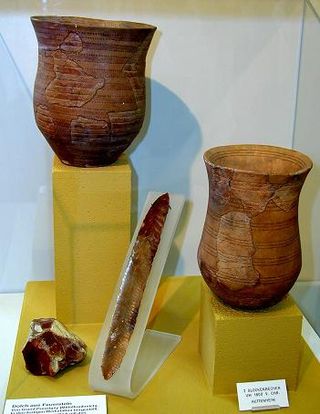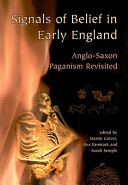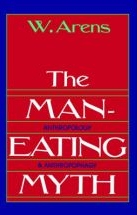Related Research Articles

Andrew Colin Renfrew, Baron Renfrew of Kaimsthorn, is a British archaeologist, paleolinguist and Conservative peer noted for his work on radiocarbon dating, the prehistory of languages, archaeogenetics, neuroarchaeology, and the prevention of looting at archaeological sites.

Vere Gordon Childe was an Australian archaeologist who specialised in the study of European prehistory. He spent most of his life in the United Kingdom, working as an academic for the University of Edinburgh and then the Institute of Archaeology, London. He wrote twenty-six books during his career. Initially an early proponent of culture-historical archaeology, he later became the first exponent of Marxist archaeology in the Western world.
Post-processual archaeology, which is sometimes alternatively referred to as the interpretative archaeologies by its adherents, is a movement in archaeological theory that emphasizes the subjectivity of archaeological interpretations. Despite having a vague series of similarities, post-processualism consists of "very diverse strands of thought coalesced into a loose cluster of traditions". Within the post-processualist movement, a wide variety of theoretical viewpoints have been embraced, including structuralism and Neo-Marxism, as have a variety of different archaeological techniques, such as phenomenology.

Culture-historical archaeology is an archaeological theory that emphasises defining historical societies into distinct ethnic and cultural groupings according to their material culture.

The Creswellian is a British Upper Palaeolithic culture named after the type site of Creswell Crags in Derbyshire by Dorothy Garrod in 1926. It is also known as the British Late Magdalenian. According to Andreas Maier: "In current research, the Creswellian and Hamburgian are considered to be independent but closely related entities which are rooted in the Magdalenian." The Creswellian is dated between 13,000 and 11,800 BP and was followed by the most recent ice age, the Younger Dryas, when Britain was at times unoccupied by humans.

Glyn Edmund Daniel was a Welsh scientist and archaeologist who taught at Cambridge University, where he specialised in the European Neolithic period. He was appointed Disney Professor of Archaeology in 1974 and edited the academic journal Antiquity from 1958 to 1985. In addition to early efforts to popularise archaeological study and antiquity on radio and television, he edited several popular studies of the fields. He also published mysteries under the pseudonym Dilwyn Rees.
Brian Murray Fagan is a British author of popular archaeology books and a professor emeritus of Anthropology at the University of California, Santa Barbara.
Michael Parker Pearson, is an English archaeologist specialising in the study of the Neolithic British Isles, Madagascar and the archaeology of death and burial. A professor at the UCL Institute of Archaeology, he previously worked for 25 years as a professor at the University of Sheffield in England, and was the director of the Stonehenge Riverside Project. A prolific author, he has also written a variety of books on the subject.
Protohistory is the period between prehistory and written history, during which a culture or civilization has not yet developed writing, but other cultures that have developed writing have noted the existence of those pre-literate groups in their own writings. For example, in Europe, the Celts and the Germanic tribes are considered to have been protohistoric when they began appearing in Greek and Roman sources.

Nazi archaeology was a field of pseudoarcheology led and encouraged by various Nazi leaders and Ahnenerbe figures, such as Adolf Hitler and Heinrich Himmler, which directed archaeologists and other scholars to search Germany's archeological past in order to find material evidence supporting an advanced, Aryan ancestry as alleged and espoused by the ultranationalist Nazi Party.

Tom Dillehay is an American anthropologist currently serving as the Rebecca Webb Wilson University Distinguished Professor of Anthropology, Religion, and Culture, as well as a Professor of Anthropology at Vanderbilt University. He has previously held teaching positions at the Universidad Austral de Chile and the University of Kentucky. Since 1977, Dillehay has been actively involved in the excavations at Monte Verde, a site in Chile where an early human settlement was discovered in 1975. Based on calibrated carbon 14 dates, Dillehay proposes that the remains found at Monte Verde are approximately 14,800 years old. This evidence challenges the prevailing Clovis theory, which suggests that the first humans arrived in the Americas around 15,000 years ago, indicating the possibility of an earlier human presence in South America.

Paleolithic religions are a set of spiritual beliefs and practices that are theorized to have appeared during the Paleolithic time period. Paleoanthropologists Andre Leroi-Gourhan and Annette Michelson believe unmistakably religious behavior emerged by the Upper Paleolithic, before 30,000 years ago at the latest, but behavioral patterns such as burial rites that one might characterize as religious — or as ancestral to religious behavior — reach back into the Middle Paleolithic, as early as 300,000 years ago, coinciding with the first appearance of Homo neanderthalensis and possibly Homo naledi.

Archaeology or archeology is the study of human activity through the recovery and analysis of material culture. The archaeological record consists of artifacts, architecture, biofacts or ecofacts, sites, and cultural landscapes. Archaeology can be considered both a social science and a branch of the humanities. It is usually considered an independent academic discipline, but may also be classified as part of anthropology, history or geography.
Deep history is a term for the distant past of the human species. As an intellectual discipline, deep history encourages scholars in anthropology, archaeology, primatology, genetics and linguistics to work together to write a common narrative about the beginnings of humans, and to redress what they see as an imbalance among historians, who mostly concentrate on more recent periods. Deep history forms the most recent part of Big History, and looks at the portion of deep time when humans existed, going further back than prehistory, mainly based on archaeology, usually ventures, and using a wider range of approaches.
Peter Stafford Bellwood is Emeritus Professor of Archaeology in the School of Archaeology and Anthropology at the Australian National University (ANU) in Canberra. He is well known for his Out of Taiwan model regarding the spread of Austronesian languages.
Julian Stewart Thomas is a British archaeologist, publishing on the Neolithic and Bronze Age prehistory of Britain and north-west Europe. Thomas has been vice president of the Royal Anthropological Institute since 2007. He has been Professor of Archaeology at the University of Manchester since 2000, and is former secretary of the World Archaeological Congress. Thomas is perhaps best known as the author of the academic publication Understanding the Neolithic in particular, and for his work with the Stonehenge Riverside Project.

Signals of Belief in Early England: Anglo-Saxon Paganism Revisited is an academic anthology edited by the British archaeologists Martin Carver, Alex Sanmark and Sarah Semple which was first published by Oxbow Books in 2010. Containing nine separate papers produced by various scholars working in the fields of Anglo-Saxon archaeology and Anglo-Saxon history, the book presents a number of new perspectives on Anglo-Saxon paganism and, to a lesser extent, early Anglo-Saxon Christianity. The collection – published in honour of the archaeologist Audrey Meaney – was put together on the basis of a conference on "Paganism and Popular Practice" held at the University of Oxford in 2005.

Peter N. Peregrine is an American anthropologist, registered professional archaeologist, and academic. He is well known for his promotion of the use of science in anthropology, and for his popular textbook Anthropology. Peregrine did dissertation research on the evolution of the Mississippian culture of North America, and conducted fieldwork on Bronze Age cities in Syria. He is currently Professor of Anthropology and Museum Studies at Lawrence University and Research Associate of the Human Relations Area Files at Yale University. From 2012 to 2018 he was an External Professor at the Santa Fe Institute.

The Man-Eating Myth: Anthropology and Anthropophagy is an influential anthropological study of socially sanctioned "cultural" cannibalism across the world, which casts a critical perspective on the existence of such practices. It was authored by the American anthropologist William Arens of Stony Brook University, New York, and first published by Oxford University Press in 1979.

Prehistoric religion is the religious practice of prehistoric cultures. Prehistory, the period before written records, makes up the bulk of human experience; over 99% of human experience occurred during the Paleolithic period alone. Prehistoric cultures spanned the globe and existed for over two and a half million years; their religious practices were many and varied, and the study of them is difficult due to the lack of written records describing the details of their faiths.
References
- ↑ "Edge article" . Retrieved 20 November 2021.
- ↑ "Univ.-Prof. Dr. Timothy Taylor, MA PhD". Universität Wien (in German). Retrieved 13 December 2012.
- ↑ Journal of World Prehistory (official website)